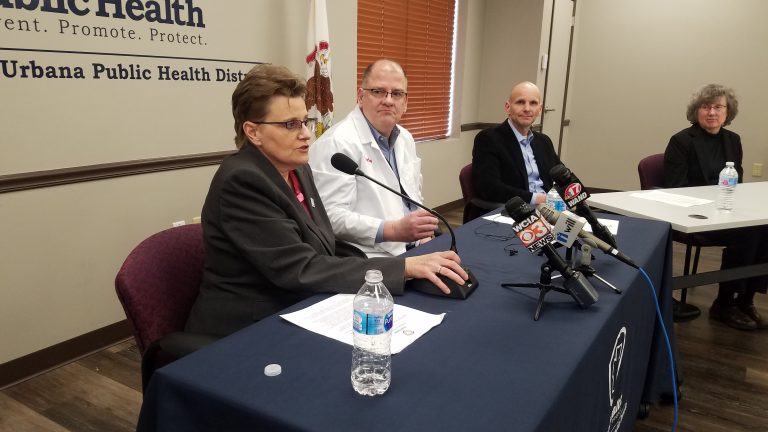URBANA – Champaign County has been living with COVID-19 for one year.
Sunday, March 15, 2020, was the day when the first COVID-19 case was announced in Champaign County. The news turned the coronavirus from a headline for county residents, to an eminent danger that has yet to let up.
An effort was made to seat people a few feet away from each other at the Champaign-Urbana Public Health District office, where a hastily organized news conference was held that Sunday to report the first case. But no face masks were worn by either health officials or reporters. Those would not be widely encouraged until a few weeks later.
Champaign-Urbana Public Health Administrator Julie Pryde told reporters that the first confirmed COVID-19 case in Champaign County was a woman in her 50s, who was recovering at home. She had been tested for the coronavirus based on her symptoms, and because she had recently met with people who had returned from Italy, where the number of COVID-19 cases was already in the tens of thousands.
At the time, Champaign County was one of just thirteen counties in Illinois to report COVID-19 cases, for a total of 93 cases statewide. There had been no reports of deaths.
But Pryde said she expected more Champaign County COVID-19 cases would soon follow.
“We are expecting more next week because we have currently over fifty cases that have been submitted and pending test results,” said Pryde.
And Pryde told reporters that the coronavirus was not going away anytime soon.
“Pandemics are not short-term events,” said Pryde. “Pandemics go usually a year or more. And they come in waves.”
Pandemic was a word that had been used by Champaign City Council member Alicia Beck, during a rare morning meeting held the previous Friday. The city council met in emergency session to grant Mayor Deb Feinen and City Manager Dorothy Davis emergency powers to deal with the coronavirus outbreak, which had been declared a worldwide pandemic by the World Health Organization on March 11, and was the subject of a disaster proclamation by Governor J.B. Pritzker on March 9.
“It’s been over a hundred years, a hundred and two years, since we had a pandemic,” said Beck, referring to the Spanish flu pandemic of 1918. “And that’s what this is. This is a pandemic. And these are things that we need to put into place in order to slow its spread.”
The emergency meeting was held in person, and 48 people viewed the proceedings from the seating area of the Champaign City Council Chamber. Council member Tom Bruno remarked that while he was normally happy to see people attending council meetings in large numbers, he thought these proceedings were best followed from a distance, now that the community was threatened by a contagious disease.
“This meeting was televised,” said Bruno. “If you didn’t need to be physically here, you might want to start reconsidering what events you need to be physically present at.”
The Urbana City Council would vote to grant its mayor similar emergency powers on Monday night. Both councils, along with other government bodies, would soon drop in-person meetings in favor of video-conferencing via Zoom or other online platforms. The emergency powers have been renewed by city council votes each month, and continue to be in effect to this day.
At the Sunday news conference, keeping potential COVID-19 patients away from other people was a top priority, as health officials moved to institute emergency practices.
“Please call us first”, said Carle Hospital Chief Quality Officer, Dr. Robert Healy. “Call us if you have symptoms. We’ll find out what your symptoms are and tell you what we think is the best course of action. For the great majority of people, that will be to stay at home and remain isolated.”
Earlier that day, Governor Pritzker ordered all bars and restaurants in Illinois to shut down indoor service for two weeks, a move that Pryde called a “wise choice” to slow down the spread of the coronavirus.
The total number of COVID-19 cases in Champaign County has grown from that one case reported one year ago, to 18,602, as of Sunday, March 14, 2121. 134 county residents with the coronavirus have died. Across Illinois, the state Department of Public Health reported 1,207,847 COVID-19 cases, including 20,924 deaths, as of Sunday.

